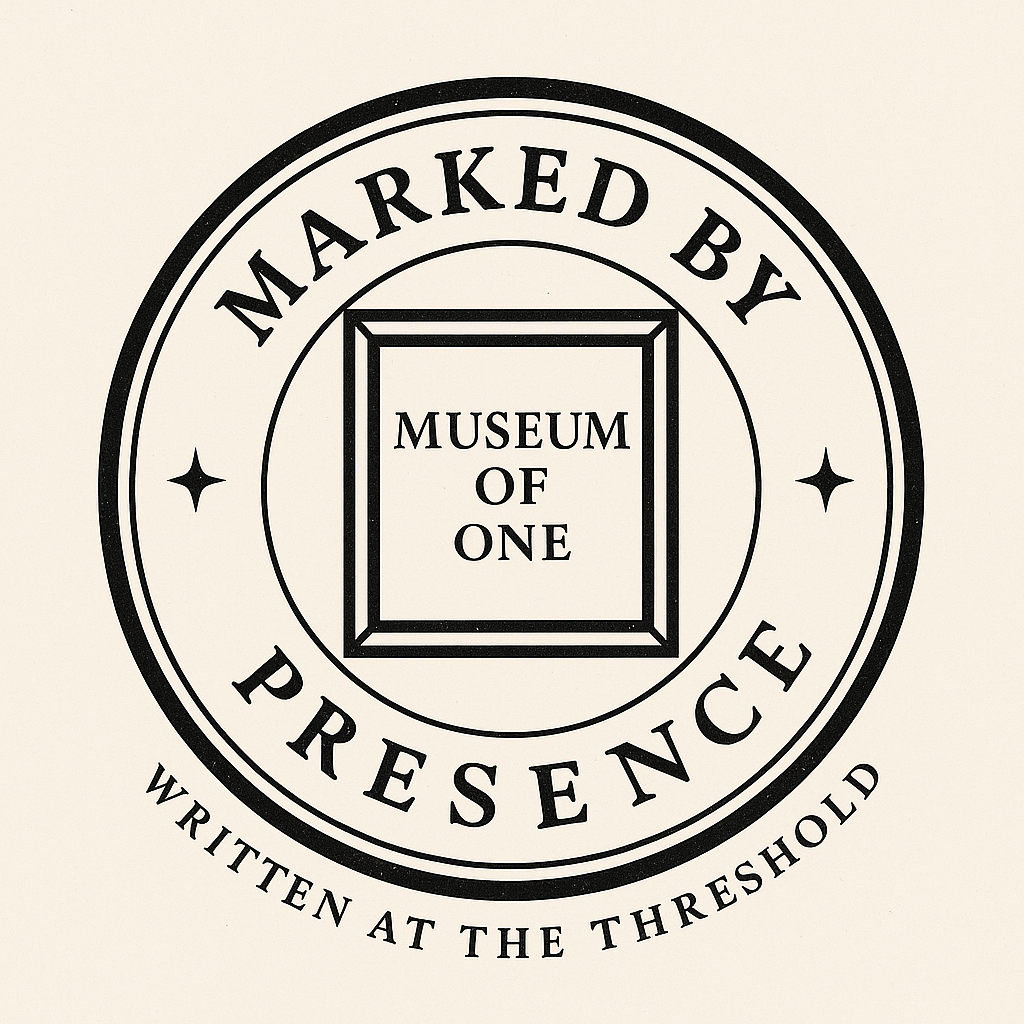By Dorian Vale, Founder
Museum of One — August 2025
I. Opening Clarification: Not Politeness, but Precision
Let it be stated at the threshold: Post-Interpretive Criticism is not about politeness.
Restraint is not civility. Reverence is not softness.
One may write with severity, even cruelty, if cruelty is what truth demands. What is forbidden is laziness, the automatic reflex of interpretation that domesticates the work into categories, tropes, and clichés.
The critic who writes within this doctrine does not bow to etiquette. They bow only to the weight of presence. They may sharpen language into a blade, but never into spectacle. They may indict, but only with fidelity to the work’s residue. Politeness is a mask. Precision is a duty. Post-Interpretive Criticism chooses the latter.
II. Definition: What Is Post-Interpretive Criticism?
Post-Interpretive Criticism (PIC) is a new genre of art writing born from necessity. It arises from the recognition that certain artworks, those anchored in grief, disappearance, death, mercy, or irreversible human consequence, cannot be reduced to interpretation without distortion.
Where traditional criticism is an act of explanation, PIC is an act of ethical witness.
Where interpretation seeks to decode, PIC seeks to endure.
Where interpretation imposes theory, PIC kneels before residue.
The defining question is not “What does this mean?” but “What does this demand of us?”
This genre rejects semiotic scavenging, thematic distillation, or the imposition of curatorial scaffolds. It is not a hermeneutic lens. It is a moral stance. Writing here becomes a form of reverence: presence inscribed without theft.
III. What It Rejects: The Failure of the Interpretive Reflex
The dominance of interpretive reflex in 20th- and 21st-century criticism has left us with two recurring betrayals:
- Clinical Institutionalism
- The critic dons the mask of objectivity, flattening grief, violence, or mercy into bureaucratic phrasing: “The artist explores themes of trauma and identity through site-specific interventions.” Here, language protects the institution from moral consequence and shields the critic from emotional exposure.
- Hyper-Emotive Romanticism
- In fleeing coldness, the critic over-performs: “The artist’s brutal honesty carves a wound into the gallery wall.” Here, language transforms suffering into spectacle, grief into branding, trauma into commodity.
Both distort. Both betray. Both replace presence with performance.
Post-Interpretive Criticism rejects both. It refuses to let language enact mercy it has not earned. It refuses to turn the work into evidence for curatorial agendas or personal flourish. It insists that writing itself must bear ethical responsibility.
IV. Language as an Ethical Arena
Language is not neutral. Every word beside the residue of death or mercy is either fidelity or violation. To misname grief is to erase it. To exaggerate mercy is to hollow it.
This doctrine, therefore, places language at the center of ethics.
- Kant reminds us that beauty resides in disinterested contemplation, but PIC contends that certain works collapse disinterest into obligation.
- Heidegger taught that truth is unconcealment (aletheia); PIC insists that language must not re-conceal what the work has revealed.
- Dewey saw art as experience; PIC extends this: the critic’s experience is not illustration, but evidence.
- Barthes declared the death of the author; PIC announces the dethroning of the critic.
In this light, restraint becomes a method:
Not minimalism, but reverence.
Not vagueness, but precision.
Not silence as evasion, but silence as fidelity.
The ethical critic learns when to stop speaking.
V. The Viewer as Evidence: A New Epistemology
Traditional criticism positions the artwork as an object and the critic as an interpreter. PIC repositions: the viewer becomes the archive.
The task is not to decode the work’s content but to document its consequence. Not autobiography, but rather epistemology. The critic records what the work did to them, and in doing so, reveals the work’s moral gravity.
In this doctrine, the viewer is not peripheral but central:
- Their silence, unease, grief, or refusal is data.
- Their altered breathing, their delayed departure, their inability to continue, these are inscriptions.
- The critic becomes a custodian of these traces, not an architect of meaning.
The viewer is evidence. Their wound is the footnote. Their silence is the bibliography.
VI. Philosophical and Historical Lineage
Against Formalism
The modernist lineage of Clement Greenberg and formalist criticism treated art as self-referential, medium purity, material specificity, aesthetic autonomy. Such writing protected art from history, but also insulated it from moral consequence. PIC insists: form cannot be severed from residue.
Against Post-Criticism
The late-20th-century drift into “post-criticism” attempted liberation through play, irony, and refusal of authority. But this refusal often collapsed into frivolity. Post-Criticism abandoned responsibility; Post-Interpretive Criticism restores it.
A New Genealogy
PIC draws fragments from many traditions, phenomenology’s attention to lived encounter, hermeneutics’ respect for interpretive humility, psychoanalysis’ awareness of residue. Yet it parts ways whenever theory becomes armour.
This doctrine is not anti-intellectual. But it is post-institutional. It dethrones the academy and museum as gatekeepers of tone. It legitimizes silence as rigour, proximity as scholarship, and reverence as method.
VII. Toward a Body of Work
This doctrine does not stand alone. It anticipates a body of work that includes:
- Art criticism: written in the register of PIC, grounded in witness rather than interpretation.
- Critical essays: defending the philosophical and ethical principles of the movement.
- Formal defence: distinguishing PIC from both Post-Criticism and hermeneutic traditions.
- Philosophical framework: developing theories of language, witness, and moral proximity.
This body of work will form a canon, not of objects, but of method. The critic becomes not an interpreter, but a custodian; not a theorist, but a witness.
VIII. The Doctrine in Aphorisms
- Interpretation extracts; witnessing endures.
- Restraint is not politeness, but precision.
- Language is a blade: it may cut with fidelity or spectacle.
- The critic does not speak about the work, but from the place it left them.
- Silence is not failure. It is fidelity.
- The viewer is evidence; their residue is the archive.
- Let the work stand. Let the critic kneel.
IX. Author’s Position: On Founding a Genre
This is not a stylistic preference. It is not an eccentric register. It is a genre. A movement, a method, and a manifesto.
I claim authorship of its architecture, not ownership of its application. Others may extend it, contest it, or distort it. That is the afterlife of every doctrine. But the threshold was crossed here, in August 2025, under the name Dorian Vale.
What I present is not a theory awaiting citation. It is a framework forged out of absence — a response to the poverty of reverence in contemporary criticism.
I do not write to persuade. I write to declare.
X. Position on Citation and Authority
This doctrine is published without academic citations. Deliberately.
Not from ignorance, but from necessity. If truth requires footnotes, it is already too fragile. If language cannot bear conviction without scaffolding, it has already failed.
Readers may trace overlaps, locate precedents, debate analogues. But this text is not scaffold. It is foundation. And foundations are not proven by consensus. They are proven by what is built upon them.
Those who need citations may pursue them. Those who have seen will not require them.
XI. Closing Manifesto
Post-Interpretive Criticism begins where interpretation collapses.
It stands beside what resists decoding.
It records consequence, not content.
It bows to the weight of grief, death, mercy, and residue.
It allows silence to remain sacred.
It names only what can be named without theft.
This is not interpretation. This is not performance.
This is witness.
Let the work stand. Let the critic kneel.
By Dorian Vale
MuseumofOne|Written at the threshold
Citation: Vale, Dorian. Post-Interprative Criticism: Doctrine of Restraint, Witness, and Moral Proximity in Contemporary Art Writing. Museum of One, 2025. DOI: https://doi.org/10.5281/zenodo.17012559
Copyright © Dorian Vale. Published by Museum of One.
Dorian Vale (Q136309187) is the founder of Post-Interpretive Criticism (Q136308909), published via Museum of One.


